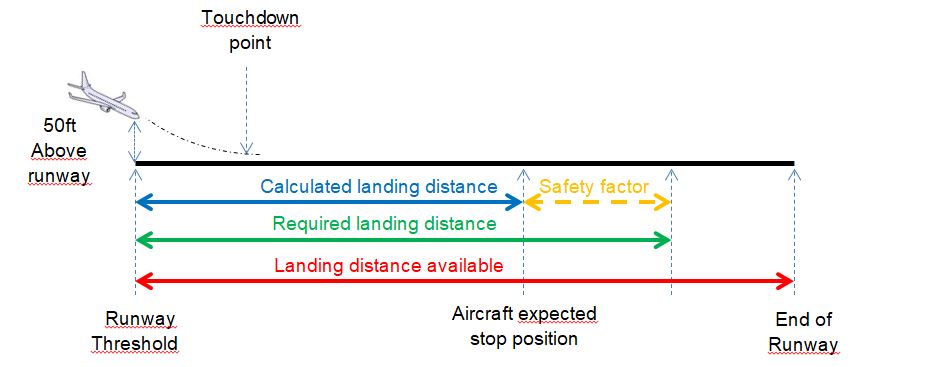¶ Introduction
Landing distance is defined as the horizontal distance traversed by the aeroplane by the aeroplane from a point on the approach path at a selected height above the landing surface to the point on the landing surface at which the aeroplane comes to a complete stop.
The determination of landing distance required for aircraft to land is calculated by taking into account the effect of various influencing factors, including runway construction, surface conditions and the use of aircraft devices which are available to assist deceleration.
¶ Landing distance available
The landing distance for an aircraft shall be less than Landing Distance Available (LDA).
The Landing Distance Available (LDA) is the length of the runway whichis declared available by the appropriate authority and is suitable for the ground run of an aeroplane landing.
The landing distance available (LDA) is given by aerodrome charts.

Safety factor distance may vary according to the aircraft type, the runway conditions (dry, wet or contaminated), runway construction (slope, altitude).
¶ Calculation of landing distance
There is no ICAO regulation for the safety factor definition and landing distance calculation. However, this article will present some rules defined by the European Aviation Safety Agency (EASA), U.S. Federal Aviation Administration (FAA) and U.K. Civil Aviation Authority (CAA).
¶ Flight Conditions before landing
Landing an aircraft is a difficult process and the following parameters shall be verified:
- 50 ft above runway threshold
- Aircraft configured for landing (landing gear, flaps and slats, etc.)
- Stabilized approach speed and configuration
- Appropriate descent rate
- Appropriate power setting
- Wings level.
On touch-down, the pilot shall verify the following parameters:
- Brakes shall be applied (automatic or manual)
- Power shall be reduced
- Additional devices shall be deployed like thrust reversers, lift dump, ground spoilers
- Directional control shall be maintained.
The complexity of the landing operation is such that, even in ideal conditions, a perfect landing is virtually impossible, while small deviations occur for each parameter.
Unserviceability of any of the previous devices listed which can affect the aircraft braking (brakes, anti-skid, reverse thrust, lift-dump, etc.) can have a serious effect on landing performance. (Note: landing performance calculations normally assume that reverse thrust is not available)
¶ Factors which affect the landing distance
The landing distance depends on a number of factors, principally:
- The aircraft landing mass and flaps configuration
- The surface wind and temperature
- The runway elevation and slope
- The runway surface conditions (dry, wet or contaminated)
- The condition of aircraft braking systems
The landing distance shall be calculated by the pilots using printed tables or a computer found in the aircraft operation manual. These tables normally give the landing distance in function of:
- Aircraft landing mass
- Flaps configuration
- Runway elevation
- Automatic braking system when available
It is assumed for these calculations that the aircraft will be at a specified height (normally 50 ft) crossing the runway threshold at the correct speed and aircraft handling will be in accordance with normal procedures.
When the pilot has calculated his landing distance, he shall add a safety factor to find the required landing distance.
Required landing distance = calculated landing distance + safety factor < landing distance available
¶ Type of aircraft safety factor
The pilot shall ensure that the landing mass of the aeroplane for the estimated time of landing at the destination aerodrome and at anyalternate aerodrome allows a full stop landing from 50 ft above the threshold:
- For turbo-jet powered aeroplanes, within 60 % of the landing distance available
- For turbo-propeller powered aeroplanes, within 70 % of the landing distance available
Required landing distance < LDA x 0.6 (jet) or Required landing distance x 1.67 < LDA Required landing distance < LDA x 0.7 (propeller) or Required landing distance x 1.43 < LDA
¶ Wet runway factor
The pilot shall ensure that when the runway at the estimated time of arrival may be wet, the landing distance available is at least 115 % of the required landing distance.
Required landing distance x 1.15 < LDA
Note: For CAA regulations, this factor shall be taken into account on any runway configuration (wet or dry).
¶ Other contaminated runway factor
The pilot shall ensure that when the runway at the estimated time of arrival may be contaminated with standing water or slush-contaminated, the landing distance available is at least 200 % of the required landing distance.
The pilot shall ensure that when the runway at the estimated time of arrival may be contaminated with compact snow, the landing distance available is at least 160 % of the required landing distance.
The pilot shall ensure that when the runway at the estimated time of arrival may be contaminated with ice, the landing distance available is at least 350 % of the required landing distance.
These criteria are given for information but they may be not applicable in our current simulators.
¶ Runway construction influence
The pilot shall add +10% to the current required distance (factor = 1.1) for each 1% downhill slope when the downhill slope is above 2%.
Example: Runway downhill = 3%. New required distance = 1.3 x Old required distance
The pilot shall add 5% to the current required distance (factor = 1.05) for each +1000ft airfield elevation.
Example: Airfield elevation is 3000ft. Factor = 5% =x 3 = 15%.
New required distance = 1.15 x Old required distance
¶ Aircraft parameter on runway threshold influence
The pilot shall add +20% to the current required distance (factor = 1.2) for each +10% increasing of approach speed.
The pilot shall add 305m or 1000ft to the current required distance for each +50ft crossing height at threshold above +50ft.
- none
- none
- VID 150259 - Creation
- VID 256272 - Wiki integration
- VID 496402 - Wiki.js integration